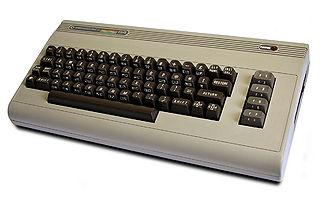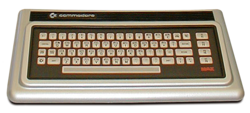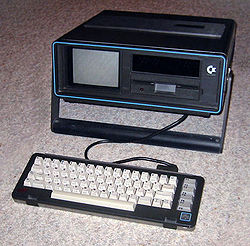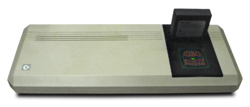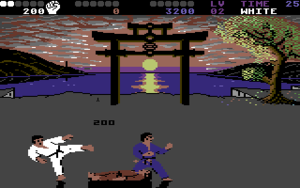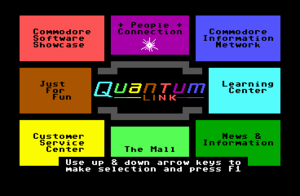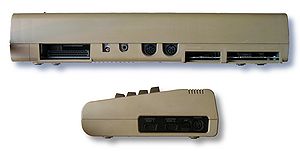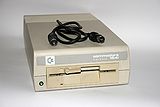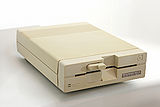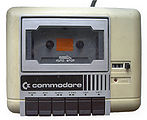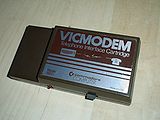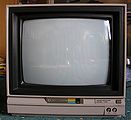Difference between revisions of "Commodore 64"
m |
m (We've got a page for that now.) |
||
| (4 intermediate revisions by 4 users not shown) | |||
| Line 1: | Line 1: | ||
[[Image:Commodore64.jpg|320px|right]] | [[Image:Commodore64.jpg|320px|right]] | ||
| + | ''This entry is copied from english Wikipedia'' | ||
| − | The '''Commodore 64''' is an 8-bit home computer introduced by Commodore International in January 1982. Volume production started in the spring of 1982, with machines being released on to the market in August at a price of US $595.Preceded by the Commodore VIC-20 and Commodore MAX Machine, the C64 features 64KB (65,536 bytes) of memory with sound and graphics performance that were superior to IBM-compatible computers of that time. It is commonly known as the '''C64''' or '''C=64''' (after the graphic logo on the case) and occasionally as the '''CBM 64''' (for '''C'''ommodore '''B'''usiness '''M'''achines), or '''VIC-64'''. It has also been affectionately nicknamed the "breadbox" and "bullnose" due to the shape and color of the first version of its casing. | + | The '''Commodore 64''' is an 8-bit home computer introduced by Commodore International in January 1982. Volume production started in the spring of 1982, with machines being released on to the market in August at a price of US $595.Preceded by the [[VIC-20|Commodore VIC-20]] and Commodore MAX Machine, the C64 features 64KB (65,536 bytes) of memory with sound and graphics performance that were superior to IBM-compatible computers of that time. It is commonly known as the '''C64''' or '''C=64''' (after the graphic logo on the case) and occasionally as the '''CBM 64''' (for '''C'''ommodore '''B'''usiness '''M'''achines), or '''VIC-64'''. It has also been affectionately nicknamed the "breadbox" and "bullnose" due to the shape and color of the first version of its casing. |
During the C64's lifetime, sales totaled between 12.5 and 17 million units, making it the best-selling single personal computer model of all time. For a substantial period of time (1983–1986), the C64 dominated the market with between 30% and 40% share and 2 million units sold per year, outselling the IBM PC clones, Apple Inc. computers, and Atari 8-bit family computers. Sam Tramiel, a former Atari president and the son of Commodore's founder, said in a 1989 interview "When I was at Commodore we were building 400,000 C64s a month for a couple of years." | During the C64's lifetime, sales totaled between 12.5 and 17 million units, making it the best-selling single personal computer model of all time. For a substantial period of time (1983–1986), the C64 dominated the market with between 30% and 40% share and 2 million units sold per year, outselling the IBM PC clones, Apple Inc. computers, and Atari 8-bit family computers. Sam Tramiel, a former Atari president and the son of Commodore's founder, said in a 1989 interview "When I was at Commodore we were building 400,000 C64s a month for a couple of years." | ||
| Line 14: | Line 15: | ||
Despite a few attempts by Commodore to discontinue the C64 in favor of other, higher priced machines, constant demand made its discontinuation a hard task. By 1988, Commodore was selling 1.5 million C64s worldwide. Although demand for the C64 dropped off in the US by 1990, it continued to be popular in the UK and other European countries. In the end, economics, not obsolescence, sealed the C64's fate. In March 1994, at CeBIT in Hanover|Hanover, Germany, Commodore announced that the C64 would be finally discontinued in 1995. Commodore stated that the C64's 1541 |disk drive was more expensive to manufacture than the C64 itself. Although Commodore had planned to discontinue the C64 by 1995, the company filed for bankruptcy a month later, in April 1994. | Despite a few attempts by Commodore to discontinue the C64 in favor of other, higher priced machines, constant demand made its discontinuation a hard task. By 1988, Commodore was selling 1.5 million C64s worldwide. Although demand for the C64 dropped off in the US by 1990, it continued to be popular in the UK and other European countries. In the end, economics, not obsolescence, sealed the C64's fate. In March 1994, at CeBIT in Hanover|Hanover, Germany, Commodore announced that the C64 would be finally discontinued in 1995. Commodore stated that the C64's 1541 |disk drive was more expensive to manufacture than the C64 itself. Although Commodore had planned to discontinue the C64 by 1995, the company filed for bankruptcy a month later, in April 1994. | ||
| + | |||
| + | |||
| Line 27: | Line 30: | ||
1982: Commodore released the Commodore MAX Machine in Japan. It is called the Ultimax in the US, and VC-10 in Germany. The MAX was intended to be a game console with limited computing capability, and was based on a very cut-down version of the hardware family later used in the C64. The MAX was discontinued months after its introduction, because of poor sales in Japan. | 1982: Commodore released the Commodore MAX Machine in Japan. It is called the Ultimax in the US, and VC-10 in Germany. The MAX was intended to be a game console with limited computing capability, and was based on a very cut-down version of the hardware family later used in the C64. The MAX was discontinued months after its introduction, because of poor sales in Japan. | ||
| − | 1983 saw Commodore attempt to compete with the Apple II's hold on the U.S. education market with the Educator 64]], essentially a C64 and monochrome monitor in a PET case. Schools preferred the all-in-one metal construction of the PET over the standard C64's separate components, which could be easily damaged, vandalized or stolen. | + | 1983 saw Commodore attempt to compete with the Apple II's hold on the U.S. education market with the [[Educator 64]], essentially a C64 and monochrome monitor in a PET case. Schools preferred the all-in-one metal construction of the PET over the standard C64's separate components, which could be easily damaged, vandalized or stolen. |
In 1984, Commodore released the SX-64, a portable version of the C64. The SX-64 has the distinction of being the first ''full-color'' portable computer. The base unit featured a CRT and an integrated 1541 floppy disk drive. The SX-64 did not have a cassette connector. | In 1984, Commodore released the SX-64, a portable version of the C64. The SX-64 has the distinction of being the first ''full-color'' portable computer. The base unit featured a CRT and an integrated 1541 floppy disk drive. The SX-64 did not have a cassette connector. | ||
| Line 40: | Line 43: | ||
In 1990, an advanced successor to the C64, the Commodore 65 (also known as the "C64DX"), was prototyped, but the project was canceled by Commodore's chairman Irving Gould in 1991. The C65's specifications were very good for an 8-bit computer. For example, it could display 256 colors on screen, while OCS based Amigas could only display 64 in HalfBrite mode (32 colors and half-bright transformations); the HAM mode on the Amiga allowed all 4096 colors of the 12 bit color system, but it was awkward to use and had restrictions on color combinations between adjacent pixels. Although no specific reason was given for the C65's cancellation, it would have competed in the marketplace with Commodore's lower end Amigas and the CDTV. | In 1990, an advanced successor to the C64, the Commodore 65 (also known as the "C64DX"), was prototyped, but the project was canceled by Commodore's chairman Irving Gould in 1991. The C65's specifications were very good for an 8-bit computer. For example, it could display 256 colors on screen, while OCS based Amigas could only display 64 in HalfBrite mode (32 colors and half-bright transformations); the HAM mode on the Amiga allowed all 4096 colors of the 12 bit color system, but it was awkward to use and had restrictions on color combinations between adjacent pixels. Although no specific reason was given for the C65's cancellation, it would have competed in the marketplace with Commodore's lower end Amigas and the CDTV. | ||
| − | |||
==Software== | ==Software== | ||
| Line 170: | Line 172: | ||
*Power supply: | *Power supply: | ||
**5V DC and 9VAC from an external "power brick", attached to a 7-pin female DIN-connector on the computer | **5V DC and 9VAC from an external "power brick", attached to a 7-pin female DIN-connector on the computer | ||
| + | |||
| + | ====Comparison==== | ||
| + | *[[Comparing C64 to CPC]] | ||
====Peripherals==== | ====Peripherals==== | ||
Latest revision as of 17:54, 22 February 2018
This entry is copied from english Wikipedia
The Commodore 64 is an 8-bit home computer introduced by Commodore International in January 1982. Volume production started in the spring of 1982, with machines being released on to the market in August at a price of US $595.Preceded by the Commodore VIC-20 and Commodore MAX Machine, the C64 features 64KB (65,536 bytes) of memory with sound and graphics performance that were superior to IBM-compatible computers of that time. It is commonly known as the C64 or C=64 (after the graphic logo on the case) and occasionally as the CBM 64 (for Commodore Business Machines), or VIC-64. It has also been affectionately nicknamed the "breadbox" and "bullnose" due to the shape and color of the first version of its casing.
During the C64's lifetime, sales totaled between 12.5 and 17 million units, making it the best-selling single personal computer model of all time. For a substantial period of time (1983–1986), the C64 dominated the market with between 30% and 40% share and 2 million units sold per year, outselling the IBM PC clones, Apple Inc. computers, and Atari 8-bit family computers. Sam Tramiel, a former Atari president and the son of Commodore's founder, said in a 1989 interview "When I was at Commodore we were building 400,000 C64s a month for a couple of years."
Part of its success was because it was sold in retail stores instead of electronics stores. Commodore produced many of its parts in-house to control supplies and cost. It is sometimes compared to the Ford Model-T automobile for its role in bringing a new technology to middle-class households via creative mass-production.
Approximately 10,000 commercial software titles were made for the Commodore 64 including development tools, office productivity applications, and games. Various C64 emulators allow anyone with a modern computer, or a compatible game console, to run these programs today. The machine is also credited with popularizing the computer demoscene|demo scene. The C64 is still used today by some computer hobbyists
In Europe, the primary competitors to the C64 were the British-built Sinclair ZX Spectrum, BBC Micro computer and the Amstrad CPC 464. In the UK, the Spectrum had been released a few months ahead of the C64, and was selling for less than half the price. The Spectrum quickly became the market leader and Commodore had an uphill struggle against the Spectrum as it could not rely on undercutting the competition. The C64 debuted at £399 in early 1983, while the Spectrum cost £175. The C64 would later rival the Spectrum in popularity in the latter half of the 1980s, eventually outliving the Spectrum, which was discontinued in December 1990.
Despite a few attempts by Commodore to discontinue the C64 in favor of other, higher priced machines, constant demand made its discontinuation a hard task. By 1988, Commodore was selling 1.5 million C64s worldwide. Although demand for the C64 dropped off in the US by 1990, it continued to be popular in the UK and other European countries. In the end, economics, not obsolescence, sealed the C64's fate. In March 1994, at CeBIT in Hanover|Hanover, Germany, Commodore announced that the C64 would be finally discontinued in 1995. Commodore stated that the C64's 1541 |disk drive was more expensive to manufacture than the C64 itself. Although Commodore had planned to discontinue the C64 by 1995, the company filed for bankruptcy a month later, in April 1994.
Contents
The C64 family
1982: Commodore released the Commodore MAX Machine in Japan. It is called the Ultimax in the US, and VC-10 in Germany. The MAX was intended to be a game console with limited computing capability, and was based on a very cut-down version of the hardware family later used in the C64. The MAX was discontinued months after its introduction, because of poor sales in Japan.
1983 saw Commodore attempt to compete with the Apple II's hold on the U.S. education market with the Educator 64, essentially a C64 and monochrome monitor in a PET case. Schools preferred the all-in-one metal construction of the PET over the standard C64's separate components, which could be easily damaged, vandalized or stolen.
In 1984, Commodore released the SX-64, a portable version of the C64. The SX-64 has the distinction of being the first full-color portable computer. The base unit featured a CRT and an integrated 1541 floppy disk drive. The SX-64 did not have a cassette connector.
Commodore, specifically two designers; Fred Bowen and Bil Herd, were determined to avoid the problems of the Plus/4, making sure that the eventual successors to the C64—the Commodore 128 and 128D computers (1985)—were as good as, and fully compatible with the original, as well as offering a host of improvements (such as a structured BASIC with graphics and sound commands, 80-column display capability, and full CP/M compatibility). The decision to make the Commodore 128 compatible with the C64 was made quietly by Bowen and Herd , software and hardware designers respectively, without the knowledge or approval by the management in the post Jack Tramiel era. The designers were careful not to reveal their decision until the project was too far along to be challenged or changed and still make the impending Consumer Electronics Show (CES) show in Las Vegas. Upon learning that the C128 was designed to be compatible with the C64, Commodore’s marketing department independently announced that the C128 would be 100% compatible with the C64, thereby raising the bar for C64 support.
In 1986, Commodore released the Commodore 64C (C64C) computer, which was functionally identical to the original, but whose exterior design was remodeled in the sleeker style of the Commodore 128 and other contemporary design trends. The modifications to the C64 line were more than skin deep in the C64C with new versions of the SID, VIC and I/O chips being deployed—with the core voltage reduced from 12 V to 9 V. In the United States, the C64C was often bundled with the third-party GEOS GUI-based operating system. The Commodore 1541 disk drive received a matching face-lift resulting in the 1541c. Later a smaller, sleeker 1541-II model was introduced along with the 800KB 3.5-inch capable 1581.
In 1990, the C64 was re-released in the form of a game console, called the C64 Games System (C64GS). A simple modification to the C64C's motherboard was made to orient the cartridge connector to a vertical position. This allowed cartridges to be inserted from above. A modified ROM replaced the BASIC interpreter with a boot screen to inform the user to insert a cartridge. It was designed to rival the Nintendo Entertainment System and the Sega Master System but it suffered from very low sales compared to its rivals and it was another commercial failure for Commodore, and it was never released outside of Europe.
In 1990, an advanced successor to the C64, the Commodore 65 (also known as the "C64DX"), was prototyped, but the project was canceled by Commodore's chairman Irving Gould in 1991. The C65's specifications were very good for an 8-bit computer. For example, it could display 256 colors on screen, while OCS based Amigas could only display 64 in HalfBrite mode (32 colors and half-bright transformations); the HAM mode on the Amiga allowed all 4096 colors of the 12 bit color system, but it was awkward to use and had restrictions on color combinations between adjacent pixels. Although no specific reason was given for the C65's cancellation, it would have competed in the marketplace with Commodore's lower end Amigas and the CDTV.
Software
At the time of its introduction, the C64's graphics and sound capabilities were rivaled only by the Atari 8-bit family. This was at a time when most IBM PCs and compatibles had text-only display adapter cards, monochrome monitors, and sound consisting of squeaks and beeps from the built-in tiny, low-quality speaker.
The C64 is often credited with starting the computer subculture known as the demoscene. The C64 lost its top position among demo coders when the 16-bit Commodore Amiga and Atari ST were released in 1985, however it still remained a very popular platform for demo coding up to the early 90s
It is still being actively used as a demo machine , especially for music (its sound chi] even being used in special sound cards for PCs, and the Elektron SidStation synthesizer). Unfortunately, the differences between PAL and NTSC C64s caused compatibility problems between U.S./Canadian C64s and those from most other countries. The vast majority of demos run only on PAL machines.
Even though it was released in 1982, the C64 was still a strong competitor to the later consoles Nintendo Entertainment System and Sega Master System] thanks to its by-then established software base.
During the 1980s, the Commodore 64 was used to run numerous Bulletin Board Systems using software packages such as Bizarre 64, Blue Board and Color 64, often with sysop-made modifications. These boards often were used to distribute cracked software.
BASIC
As was common for machines of the time, the C64 incorporated a ROM based version of the BASIC programming language. Commodore BASIC 2.0 was used instead of the more advanced BASIC 4.0 from the PET series, since its users were not expected to need the disk-oriented enhancements of BASIC 4.0. "The choice of BASIC 2.0 instead of 4.0 was made with some soul-searching, not just at random. The typical user of a C64 is not expected to need the direct disk commands as much as other extensions, and the amount of memory to be committed to BASIC was to be limited. We chose to leave expansion space for color and sound extensions instead of the disk features. As a result, you will have to handle the disk in the more cumbersome manner of the 'old days'."
The version of BASIC was limited and did not include commands for sound or graphics manipulation, instead users had to use the "POKE" command to access the graphics and sound chip registers directly. In order to provide extended commands including graphics and sound Commodore produced two different cartridge-based extension to BASIC 2.0 — Simons' BASIC and Super Expander 64.
Alternative operating systems
A number of third party operating systems have been developed for the C64.
As well as the original GEOS, two third-party GEOS-compatible operating systems have been written: Wheels and GEOS megapatch. Both of these require hardware upgrades to the original C64.
Several other operating systems are or have been available, including WiNGS OS, the Unix-like LUnix, operated from a command-line, and the embedded systems OS Contiki, with full GUI. Other less well known OSes include ACE, Asterix, DOS/65 and GeckOS.
A version of CP/M was released, but this required the addition of an external Z80 processor to the expansion bus, so is not considered a true C64 OS. Furthermore, the Z80 processor was underclocked to be compatible with the C64's memory bus, so performance was poor compared to other CP/M implementations. C64 CP/M and C128 CP/M both suffered a lack of software: although most commercial CP/M software would technically run on these systems, software media was incompatible between platforms. The low usage of CP/M on Commodores meant that software houses saw no need to invest in mastering versions for the Commodore filesystem. The Commodore 1571 disk drive was made compatible with a wide variety of disk formats to eliminate this weakness.
Networking software
Quantum Link (or Q-Link) was a U.S. and Canadian online service for Commodore 64 and 128 personal computers that operated from November 5, 1985 to November 1, 1994. It was operated by Quantum Computer Services of Vienna, Virginia, which in October 1991 changed its name to America Online, and continues to operate its AOL service for the IBM PC and Apple Macintosh today. Q-Link was a modified version of the PlayNET system, which Control Video Corporation (CVC, later renamed Quantum Computer Services) licensed.
The Quantum Link networking service became America Online which became AOL-Time Warner which was then contracted to AOL.
Hardware
CPU and memory
The C64 uses an 8-bit MOS Technology 6510 microprocessor. This is a close derivative of the 6502 with an added 6-bit internal I/O port that in the C64 is used for two purposes: to bank-switch the machine's ROM in and out of the processor's address space, and to operate the datasette tape recorder.
The C64 has 64B of RAM, of which 38kB are available to built-in Commodore BASIC 2.0.
Graphics
The graphics chip, VIC-II, features 16 colors, eight hardware sprites per scanline (enabling up to 112 sprites per PAL screen), scrolling capabilities, and two bitmap graphics modes. The standard text mode features 40 columns, like most Commodore PET models; the built in character encoding is not standard ASCII but PETSCII, an extended form of ASCII-1963.
Most screen shots show borders around the screen, which is a feature of the VIC-II chip. By utilising interrupts to reset various hardware registers on precise timings it was possible to place graphics within the borders and thus utilise the full screen.
Sound
The sound chip, SID, has three channels, each with its own ADSR envelope generator, ring modulation and filter capabilities. It was designed by Bob Yannes, who would later co-found synthesizer company Ensoniq. Yannes criticized other contemporary computer sound chips as "primitive, obviously... designed by people who knew nothing about music". Often the game music became a hit of its own among C64 users. Well-known composers and programmers of game music on the C64 are Rob Hubbard, David Whittaker, Chris Hulsbeck, Ben Daglish, Martin Galway among many others. Due to the chip's limitation to three channels, chords are played as arpeggios typically, coining the C64's characteristic lively sound. It was also possible to continuously update the master volume with sampled data to enable the playback of 4-bit digitized audio. As of 2008 it even became possible to play 4 channel 8 bit audio samples, 2 SID channels and still use filtering.
There are two versions of the SID chip, the 6581 and the 8580. The MOS Technology 6581 was used in all of the original "breadbox" C64s, the early versions of the C64C and the Commodore 128. The 6581 was replaced with the MOS Technology 8580 in 1987. The 6581 sound quality is a little more crisp, and many Commodore 64 fans prefer its sound. The main difference between the 6581 and the 8580 is the supply voltage. The 6581 uses a 12 volt supply, the 8580, a nine volt supply. A modification can be made to use the 6581 in a C64C board (which uses the nine volt chip).
The SID chip has a distinctive sound which retained a following of devotees to such a degree, that a number of audio enthusiasts and companies have designed SID-based products as add-ons for the C64, x86 PCs and standalone or MIDI music devices such as the Elektron SidStation. These devices use chips taken from excess stock, or removed from used computers.
In 2007, Timbaland's extensive use of the SidStation led to the 2007 Timbaland plagiarism controversy around his tracks Block Party and Do It (written for Nelly Furtado).
Hardware revisions
Cost reduction was the driving force behind the C64's motherboard revisions. Reducing manufacturing costs was vitally important to Commodore's survival during the price war and leaner years of the 16-bit era. The C64's original (NMOS based) motherboard would go through two major redesigns, (and numerous sub-revisions) exchanging positions of the VIC-II, SID and PLA chips. Initially, a large portion of the cost was eliminated by reducing the number of discrete components, such as diodes and resistors, which enabled the use of a smaller printed circuit board.
ICs
The VIC-II was manufactured with 5 micrometre] NMOS technology and was clocked at either 17.73447MHz (PAL) or 14.31818MHz (NTSC). Internally, the clock was divided down to generate the dot clock (about 8MHz) and the two-phase system clocks (about 1MHz; the exact pixel and system clock speeds are slightly different between NTSC and PAL machines). At such high clock rates, the chip generated a lot of heat, forcing MOS Technology to use a ceramic DIL package (called a "CERDIP"). The ceramic package was more expensive, but it dissipated heat more effectively than plastic.
After a redesign in 1983, the VIC-II was encased in a plastic Dual Inline Package, which reduced costs substantially, but it did not totally eliminate the heat problem. Without a ceramic package, the VIC-II required the use of a heat sink. To avoid extra cost, the metal RF shielding doubled as the heat sink for the VIC, although not all units shipped with this type of shielding. Most C64s in Europe shipped with a cardboard RF shield, coated with a layer of metal foil. The effectiveness of the cardboard was highly questionable, and worse still it acted as an insulator, blocking airflow which trapped heat generated by the SID, VIC, and PLA chips.
The SID was manufactured using NMOS at 7 and in some areas 6 micrometers. The prototype SID and some very early production models featured a ceramic Dual Inline Package, but unlike the VIC-II, these are extremely rare as the SID was encased in plastic when production started in early 1982.
Motherboard
In 1986, Commodore released the last revision to the classic C64 motherboard. It was otherwise identical to the 1984 design, except for the two 64 kilobit * 4 bit DRAM chips that replaced the original eight 64 kilobit * 1 bit ICs.
After the release of the C64C, MOS Technology began to reconfigure the C64's chipset to use HMOS production technology. The main benefit of using HMOS was that it required less voltage to drive the IC, which consequently generates less heat. This enhanced the overall reliability of the SID and VIC-II. The new chipset was re-numbered to 85xx in order to reflect the change to HMOS.
In 1987 Commodore released C64Cs with a totally redesigned motherboard commonly known as a "short board". The new board used the new HMOS chipset, featuring a new 64-pin PLA chip. The new "SuperPLA", as it was dubbed, integrated many discrete components and TTL chips. In the last revision of the C64C motherboard, the 2114 color RAM was integrated into the SuperPLA.
Power supply
The C64 used an external power supply. This saved space within the computer's case. The 1541-II and 1581 disk drives, along with various third-party clones, also came with their own external power supply "bricks". These power supplies were notorious for failing over time. Many lasted less than two years and had to be replaced. Commodore later changed the design, however the new version was also prone to failure. It has been speculated that these supplies failed due to voltage regulator overheating. They were entirely encapsulated within an epoxy resin, a poor conductor of heat and impossible to repair. As of 2010, many Commodore 64 owners use home-made power supplies, often using separate 5 volt DC and 9 volt AC power supplies, wired to a common plug that attaches to the Commodore 64.
Specifications
Internal hardware
- Microprocessor CPU:
- MOS Technology 6510|MOS Technology 6510/8500 (the 6510/8500 being a modified 6502 with an integrated 6-bit I/O port)
- Clock speed: 0.985 MHz (PAL) or 1.023 MHz (NTSC)
- Video: MOS Technology VIC-II 6567/8562 (NTSC), 6569/8565 (PAL)
- 16 colors
- Text mode: 40*25 characters; 256 user-defined chars (8*8 pixels, or 4*8 in multicolor mode); 4-bit color RAM defines foreground color
- Bitmap modes: 320*200 (2 unique colors in each 8*8 pixel block), 160*200 (3 unique colors + 1 common color in each 4*8 block)
- 8 hardware sprites of 24*21 pixels (12*21 in multicolor mode)
- Smooth scrolling, raster interrupts
- Sound: MOS Technology 6581/8580 SID
- 3-channel synthesizer with programmable ADSR envelope
- 8 octaves
- 4 waveforms per audio channel: triangle, sawtooth, variable pulse, noise
- Oscillator synchronization, ring modulation
- Programmable filter: high pass, low pass, band pass, notch filter
- Input/Output: Two 6526 Complex Interface Adapters
- 16 bit parallel I/O
- 8 bit serial I/O
- 24-hours (AM/PM) Time of Day clock (TOD), with programmable alarm clock
- 16 bit interval timers
- RAM:
- 64kB, of which 38kB (minus 1 byte) were available for BASIC programs
- 512 bytes color RAM (memory allocated for screen color data storage)
- Expandable to 320kB with Commodore 1764 256kB RAM Expansion Unit (REU); although only 64kB directly accessible; REU mostly intended for GEOS. REUs of 128kB and 512kB, originally designed for the C128, were also available, but required the user to buy a stronger power supply from some third party supplier; with the 1764 this was included. Creative Micro Designs also produced a 2MB REU for the C64 and C128, called the 1750 XL. The technology actually supported up to 16MB, but 2MB was the biggest one officially made. Expansions of up to 16MB were also possible via the CMD SuperCPU.
- ROM:
- 20kB (9kB BASIC 2.0; 7kB Kernel; 4kB character generator, providing two 2kB character sets)
I/O ports and power supply
- I/O ports:
- Cartridge expansion slot (slot for edge connector with 6510 CPU address/data bus lines and control signals, as well as GND and voltage pins; used for program modules and memory expansions, among others)
- Integrated RF modulator antenna output via a RCA connector. The used channel could be adjusted from number 36 with the potentiometer to the left.
- 8-pin DIN connector containing composite video output, separate Y/C outputs and sound input/output. Beware that this is the 270° (horseshoe) version of the plug, not the 360° circular version. Also note that some early C64 units use a 5-pin DIN connector that carries composite video and luminance signals, but lacks a chroma signal.
- Serial bus (serial version of IEEE-488, 6-pin DIN plug) for CBM printers and disk drives
- PET-type Commodore Datassette 300 baud tape interface (edge connector with digital cassette motor/read/write/key-sense signals, Ground and +5V DC lines. The cassette motor is controlled by a +5V DC signal from the 6502 CPU. The 9 V AC input is transformed into unregulated 6.36 V DC which is used to actually power the cassette motor.
- User port (edge connector with TTL-level signals, for modems etc.; byte-parallel signals which can be used to drive third-party parallel printers, among other things, 17 logic signals, 7 Ground and voltage pins, including 9V AC)
- 2 * screwless DE9M game controller ports (compatible with Atari 2600 controllers), each supporting five digital inputs and two analog inputs. Available peripherals included digital joysticks, analog paddles, a light pen, the Commodore 1351 mouse, and the unique KoalaPad.
- Power supply:
- 5V DC and 9VAC from an external "power brick", attached to a 7-pin female DIN-connector on the computer
